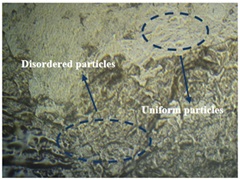Synthesis, Microstructure, Optical Properties, and Sensitive Amoxicillin Detection of Carbon Dots
Abstract
The detection of amoxicillin has been successfully carried out using C-dot fluorescence probes made from d-glucose and urea. The fluorescence probe has an intense bright blue emission under UV light at 395 nm and and depends on the excitation and depends on the excitation. Raman studies successfully showed a D peak at 1381 cm-1 and a G peak at 1586 cm-1 associated with graphitic and amorphous structures. The absorption peaks in UV-vis spectroscopy confirm transitions at 275 nm (π → π*) and 322 nm (n → π*) with the presence of conjugated C=C and carbonyl (C=O) functional groups. The results of the fluorescence test show a bright blue color, with its intensity measured at an excitation of 365 nm. This can be attributed to nitrogen incorporation on the surface of the C-dots derived from urea, resulting in a quantum yield of 54%. This fluorescence probe is highly sensitive in detecting amoxicillin, as evidenced by the successful detection of AMX at concentrations of 10–30 μM and a resulting LOD of 5.75443×10−7 nM. The microstructure shows a uniform size of C-dot nanoparticles, and C-dot modeling was created. C-dot probes have an LOD of 5.75443×10−7 nM, indicating high sensitivity in detecting AMX.
Downloads

Copyright (c) 2025 Yuni Aldriani Lubis, Saharman Gea, Muhammad Frassetia Lubis, Woei Wu Larry Pai, Marpongahtun Marpongahtun

This work is licensed under a Creative Commons Attribution-NonCommercial-NoDerivatives 4.0 International License.
Authors who publish with this journal agree to the following terms:
- Copyright on any article is retained by the author(s).
- The author grants the journal, the right of first publication with the work simultaneously licensed under a Creative Commons Attribution License that allows others to share the work with an acknowledgment of the work’s authorship and initial publication in this journal.
- Authors are able to enter into separate, additional contractual arrangements for the non-exclusive distribution of the journal’s published version of the work (e.g., post it to an institutional repository or publish it in a book), with an acknowledgment of its initial publication in this journal.
- Authors are permitted and encouraged to post their work online (e.g., in institutional repositories or on their website) prior to and during the submission process, as it can lead to productive exchanges, as well as earlier and greater citation of published work.
- The article and any associated published material is distributed under the Creative Commons Attribution-NonCommercial-NoDerivatives 4.0 International License.





_copy1.png)










